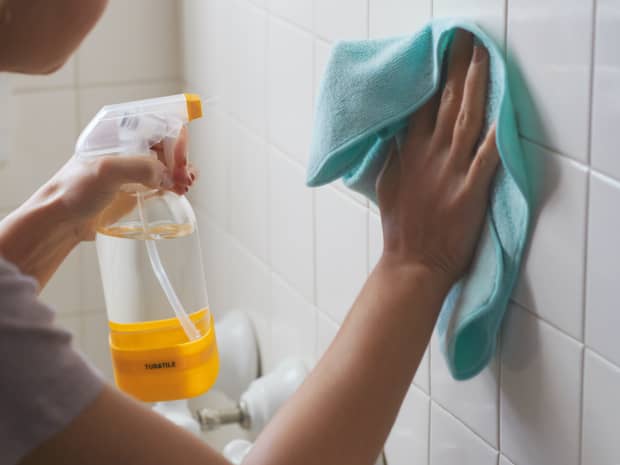
How To Clean a Toaster Oven
An amazing toaster oven can quickly turn into a grimy mess. Clean it with our step-by-step cleaning guide.
Read More


Last Updated: May 26, 2022
An oft-overlooked kitchen appliance, your dishwasher deserves an occasional deep scrub to keep it working its best — and your dishes free from grime.
As an oft-overlooked kitchen appliance, your dishwasher deserves an occasional deep scrub to keep it working its best — and to keep your dishes free from grime.
Yes, we know, the idea of cleaning your dishwasher seems a little strange. After all, isn’t it getting a thorough rinse every time you run it? Your dishwasher, however, needs a little extra TLC to be truly clean. There’s a lot of grime, musty odors, and germs that can accumulate — especially if you don’t take the time to give it a good scrub.
If you notice your supposedly clean dishes don’t seem to be getting as clean as you’d like, it’s probably time to give your dishwasher some love. Thankfully, cleaning your dishwasher isn’t all that hard. Even better? You don’t need to buy expensive cleaners with questionable ingredients to give your dishwasher a deep clean. All you need are a few environmentally friendly and affordable kitchen staples to help your dishwasher sparkle.
Grove Tip
A smelly odor is a telltale sign that germs have taken over your dishwasher. Visible grime, bits of food in the dishwasher drain, moldy looking buildup in the nooks and crannies, and the fact that your dishes aren’t emerging from the dishwasher with their usual sparkle and shine are other good indicators it’s time for a cleaning.

If you can remove the racks, you’ll have even better access to the spray arms.
The best way to clear dirt or grime out of the spray arms is to use a small piece of wire or a toothpick to help dig out debris in each spray arm. You can also use a small scrub brush and mild dish soap to clean the arms and remove anything that’s caked on.
No matter how powerful of a dishwasher you have, or even if you use a natural dishwasher detergent to avoid questionable ingredients, build up can still accumulate in filters over time.
Older model dishwashers may have a self-cleaning filter, in which case you probably won’t have to do much. Filters that are self-cleaning are often loud, a tell-tale sign your dishwasher may have one.
Determine which filter you have by looking at the bottom of your dishwasher. Self-cleaning filters have holes or a grid-looking contraption over the top of the filter.
Manual-clean filters look like a round plastic piece beneath the bottom spray arms that’s removable. Remove your manual filter, if that’s what you have, and wash the removable part with hot, soapy water or with cleaning vinegar, using the scrub brush to clean all the places gunk has collected.
You can remove any remaining food that’s visible in the filter after each use, and then follow your dishwasher’s instruction manual to disassemble and remove the filter completely for a good scrub every few weeks.
Using your small scrub brush and dish soap, clean the utensil holder and the racks wherever you see visible grime and soap scum. Food debris can easily get caught in utensil holders because of the grid design, so you’ll need small bristles to get down in the crevices to clean it properly.
You can also go the extra mile and use an all-purpose cleaner and sponge or microfiber cloth to clean the inside of the door and in and around the detergent holder, where buildup can accumulate. Use the small scrub brush to get where your cloth can’t reach.
Every dishwasher has rubber seals around the opening of the dishwasher to help seal it closed when in use. In fact, according to research, if the rubber seals are not cleaned, it can become a place where bacteria and mold can easily grow.
Use a scrub brush or soft microfiber cloth and go to town with either cleaning vinegar or a dish soap and water mixture, paying close attention to not only the seals but also the door edges.
The final step is to fill a dishwasher-safe cup with white distilled vinegar and place it on the top rack of the dishwasher. Make sure the cup doesn’t have a lid on it, and set your dishwasher on the hot wash cycle or hot water cycle. Vinegar will help break down any remaining grime and residue that’s built up while helping to eradicate odors.
Grove Tip
If you have a stainless steel dishwasher, a specially formulated cleanser for stainless steel easily removes any marks or fingerprints. These formulas offer the bonus of helping to prevent future prints; just remember to use a soft microfiber cloth when applying the cleaner. Otherwise, you might scratch the surface and make a bad situation worse.
Even if your dishwasher isn’t stainless steel, the outside door could still probably use a good wipe and polish. Use a natural wipe or just a damp microfiber cloth and all-purpose cleaner to give it a good clean.
There are no rules, but you should generally do minor cleaning tasks weekly, and give your dishwasher a deep clean every few weeks or so. Minor cleaning tasks include checking the drain trap for bits of food every time you use it and wiping down any visible grime when you see it.
Investing in a natural dish soap that’s tough on food (but still gentle on your hands and the environment!), and giving your dishes a good — but not overly thorough — scrub before putting them in the dishwasher can help keep your dishwasher fresh longer in between deep cleans.
The cleanliness of your dishwasher is simple to maintain. Just deep clean it every couple of months and spray down the inside with vinegar periodically to help keep everything fresh and sparkling.
More of a visual learner? We get it! Follow our clean minute breakdown of how to tackle your dishwasher — just hit play.
Looking for more inspiration? Check out our entire Clean Minute series for pointers on tackling your home's trickiest cleaning tasks.

Ready to tackle the dirtiest spots in your home? Grove Collaborative has you covered with Clean Team. Each week, we’ll do a deep dive into how to clean a different place or item in your home. No spot is too small — and we’ll tell you how to conquer them all, naturally.

An amazing toaster oven can quickly turn into a grimy mess. Clean it with our step-by-step cleaning guide.

Find out some of the best ways to clean the burners on your gas stovetop with this step-by-step guide.

Our ultimate guide to cleaning your oven makes it easy to tackle this tough task with natural products.

We’ve compiled some of our best tips and tricks on how to remove soap scum to set you up for success in the cleaning process.